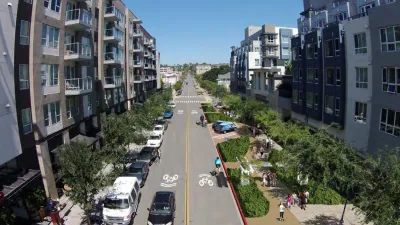Some media commentary suggests that fast-gentrifying cities such as Washington are unable to attract families. In Washington, the reality is more complex; the city's high-income neighborhoods actually gained children over the past decade.
One response to urban gentrification are the claim that even prosperous cities are childless cities, able to retain twenty-somethings but not to retain families. A recent study of Washington by the Urban Institute allowed me to analyze this theory on a neighborhood-by-neighborhood basis, rather than merely relying on citywide data.
In particular, I examined the Institute's division of the city into neighborhood clusters: groups of two or three similar areas. I found that some types of neighborhoods were indeed losing children, but that other parts of the District actually became more attractive to families over the past decade.
The city's traditionally low-income areas east of the Anacostia River did indeed lose children; every single neighborhood cluster east of the river had fewer children in 2010 than in 2000. In Ward 8 (the city's far southeastern corner) the number of children decreased by 16 percent during the 2000s. Other poor areas in eastern Washington sustained similar losses.
In newly gentrifying areas just east of Rock Creek Park, the number of children declined even more rapidly. For example, in the Mt. Pleasant/Columbia Heights neighborhood cluster (where the non-Hispanic white population nearly tripled between 1990 and 2010) the number of children decreased by 32 percent over the past decade. In this area, it appears that working-class families left and middle-class singles and couples took their place.
But in the city's always-affluent areas west of Rock Creek Park, the number of children increased in six out of seven neighborhood clusters. For example, in Georgetown/Burleith, the child population increased by 46 percent.
So it appears that (at least in Washington) long-established affluent neighborhoods are able to retain families.

Alabama: Trump Terminates Settlements for Black Communities Harmed By Raw Sewage
Trump deemed the landmark civil rights agreement “illegal DEI and environmental justice policy.”

Study: Maui’s Plan to Convert Vacation Rentals to Long-Term Housing Could Cause Nearly $1 Billion Economic Loss
The plan would reduce visitor accommodation by 25% resulting in 1,900 jobs lost.

Planetizen Federal Action Tracker
A weekly monitor of how Trump’s orders and actions are impacting planners and planning in America.

Wind Energy on the Rise Despite Federal Policy Reversal
The Trump administration is revoking federal support for renewable energy, but demand for new projects continues unabated.

Passengers Flock to Caltrain After Electrification
The new electric trains are running faster and more reliably, leading to strong ridership growth on the Bay Area rail system.

Texas Churches Rally Behind ‘Yes in God’s Back Yard’ Legislation
Religious leaders want the state to reduce zoning regulations to streamline leasing church-owned land to housing developers.
Urban Design for Planners 1: Software Tools
This six-course series explores essential urban design concepts using open source software and equips planners with the tools they need to participate fully in the urban design process.
Planning for Universal Design
Learn the tools for implementing Universal Design in planning regulations.
Caltrans
Smith Gee Studio
Institute for Housing and Urban Development Studies (IHS)
City of Grandview
Harvard GSD Executive Education
Toledo-Lucas County Plan Commissions
Salt Lake City
NYU Wagner Graduate School of Public Service






























